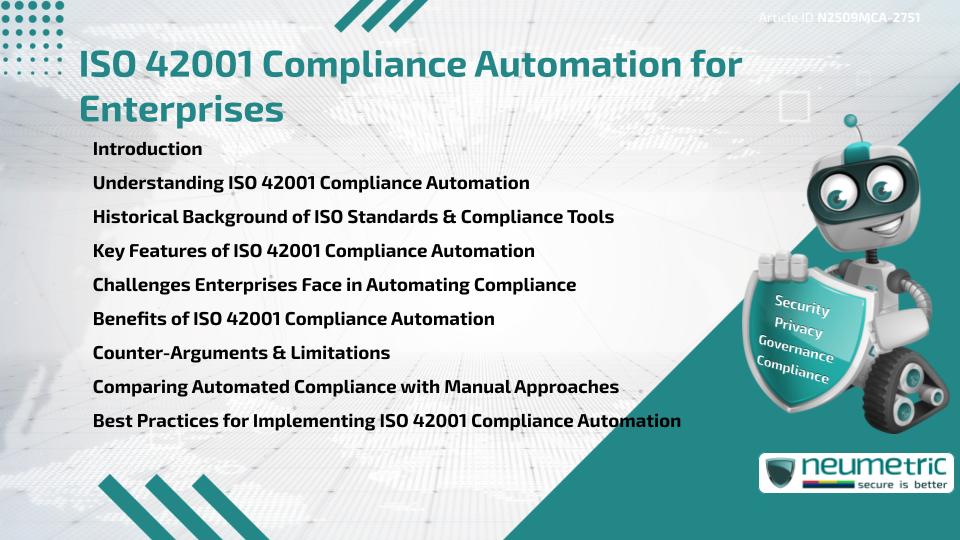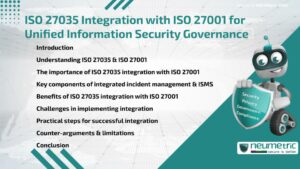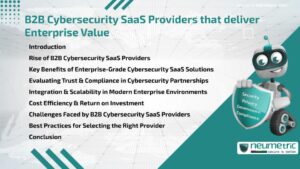Table of Contents
ToggleIntroduction
The ISO 42001 Compliance Automation Framework enables enterprises to streamline the monitoring & management of Artificial Intelligence [AI] Governance systems. Instead of relying solely on manual processes, automation tools ensure real-time oversight, consistent reporting & faster adaptation to regulatory changes. By adopting ISO 42001 Compliance Automation, enterprises can reduce human error, enhance accountability & maintain ongoing alignment with international standards.
Understanding ISO 42001 Compliance Automation
ISO 42001 Compliance Automation refers to the use of digital tools, software platforms & AI-driven monitoring systems to oversee adherence to the ISO 42001 standard. It replaces repetitive manual tasks-such as documentation, audits & Risk tracking-with automated processes. For enterprises, automation transforms compliance from a time-consuming obligation into a dynamic, efficient & proactive function.
Historical Background of ISO Standards & Compliance Tools
ISO standards have long established benchmarks for quality, safety & Governance, including ISO 9001 for Quality Management & ISO 27001 for Information Security. Over time, compliance practices evolved from manual audits to digital solutions. With ISO 42001 focusing on AI Management Systems, automation has become a critical element for enterprises dealing with the speed & complexity of AI technologies.
Key Features of ISO 42001 Compliance Automation
An effective ISO 42001 Compliance Automation system typically includes:
- Automated reporting: Generating Compliance Reports without manual input.
- Real-time monitoring: Tracking AI System performance against compliance metrics.
- Risk detection tools: Identifying Vulnerabilities & Non-Conformities automatically.
- Audit trail creation: Maintaining continuous logs of compliance-related activities.
- Integration capabilities: Connecting with enterprise systems such as HR, IT & data Governance platforms.
- Regulatory updates: Incorporating changes in Compliance Requirements into workflows.
Challenges Enterprises Face in Automating Compliance
Enterprises may face obstacles when adopting ISO 42001 Compliance Automation. High implementation costs, integration challenges with legacy systems & the need for skilled staff to manage automation tools are common barriers. Additionally, Organisations may struggle with balancing automation & human judgment, especially in areas like ethics & accountability.
Benefits of ISO 42001 Compliance Automation
Despite challenges, ISO 42001 Compliance Automation offers major advantages:
- Reduces administrative workload & human error.
- Enhances transparency with real-time visibility into compliance status.
- Improves agility by quickly adapting to regulatory or operational changes.
- Provides clear documentation to demonstrate accountability to Stakeholders.
- Increases efficiency, freeing up resources for strategic decision-making.
Counter-Arguments & Limitations
Some critics argue that over-reliance on automation may create a “checkbox mentality,” where Organisations focus on system outputs instead of genuine compliance. Others note that automation cannot fully address nuanced ethical considerations in AI Management. While these concerns are valid, combining automation with human oversight creates a balanced & effective compliance Framework.
Comparing Automated Compliance with Manual Approaches
Traditional manual compliance processes rely heavily on periodic audits & staff-driven reporting. While valuable, these methods are prone to delays & inconsistencies. In contrast, ISO 42001 Compliance Automation ensures continuous oversight, offering enterprises greater accuracy & speed. This transition reflects broader industry trends toward digital Governance & proactive Risk Management.
Best Practices for Implementing ISO 42001 Compliance Automation
To maximize the value of ISO 42001 Compliance Automation, enterprises should:
- Conduct a Readiness Assessment before implementing automation tools.
- prioritise high-Risk areas for automation, such as Risk detection & reporting.
- Train Employees to interpret automated insights & act responsibly.
- Use hybrid models that combine automation with human expertise.
- Regularly evaluate automation tools for accuracy, scalability & relevance.
Conclusion
The ISO 42001 Compliance Automation Framework empowers enterprises to streamline compliance processes, reduce Risks & adapt to rapid changes in AI Governance. By combining automation tools with expert oversight, Organisations can achieve efficient, accountable & sustainable compliance.
Takeaways
- ISO 42001 Compliance Automation streamlines compliance through digital tools.
- Key features include automated reporting, real-time monitoring & Risk detection.
- Challenges include cost, integration & the need for skilled staff.
- Automation provides efficiency, transparency & adaptability when paired with human oversight.
FAQ
What is ISO 42001 Compliance Automation?
It is the use of digital tools to streamline compliance processes for AI Management Systems under ISO 42001.
Why is automation important for compliance?
It reduces errors, saves time & ensures continuous oversight of AI Systems.
What features do automation tools include?
They include automated reporting, monitoring, Risk detection, Audit trails & regulatory updates.
What challenges do enterprises face with compliance automation?
Challenges include high costs, integration issues & balancing automation with human judgment.
How does automation differ from manual compliance processes?
Automation provides real-time, continuous oversight, while manual methods depend on periodic audits.
Can small enterprises use ISO 42001 Compliance Automation?
Yes, tools can be scaled to fit the size & resources of smaller Organisations.
References
- ISO – Artificial Intelligence Management System Standards
- NIST – AI Risk Management Framework
- OECD – AI Principles
- ISO – Standards and Certification Overview
- Council of Europe – Artificial Intelligence and Human Rights
Need help for Security, Privacy, Governance & VAPT?
Neumetric provides organisations the necessary help to achieve their Cybersecurity, Compliance, Governance, Privacy, Certifications & Pentesting needs.
Organisations & Businesses, specifically those which provide SaaS & AI Solutions in the Fintech, BFSI & other regulated sectors, usually need a Cybersecurity Partner for meeting & maintaining the ongoing Security & Privacy needs & requirements of their Enterprise Clients & Privacy conscious Customers.
SOC 2, ISO 27001, ISO 42001, NIST, HIPAA, HECVAT, EU GDPR are some of the Frameworks that are served by Fusion – a SaaS, multimodular, multitenant, centralised, automated, Cybersecurity & Compliance Management system.
Neumetric also provides Expert Services for technical security which covers VAPT for Web Applications, APIs, iOS & Android Mobile Apps, Security Testing for AWS & other Cloud Environments & Cloud Infrastructure & other similar scopes.
Reach out to us by Email or filling out the Contact Form…





